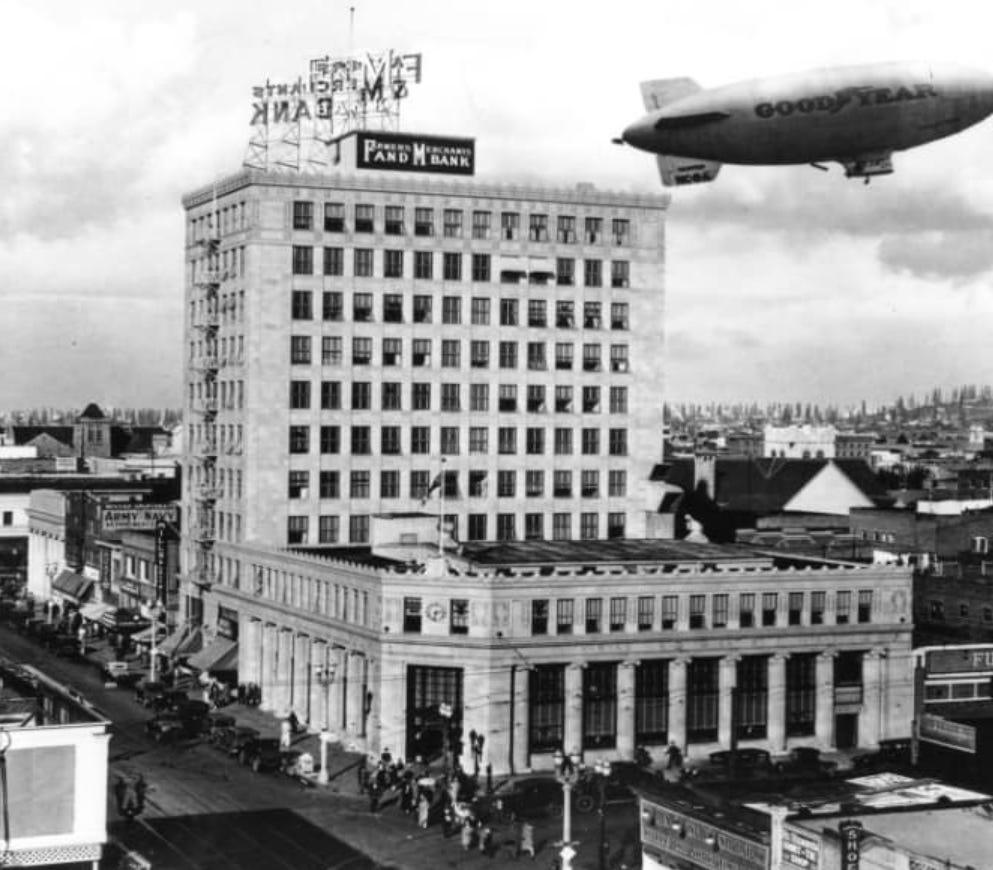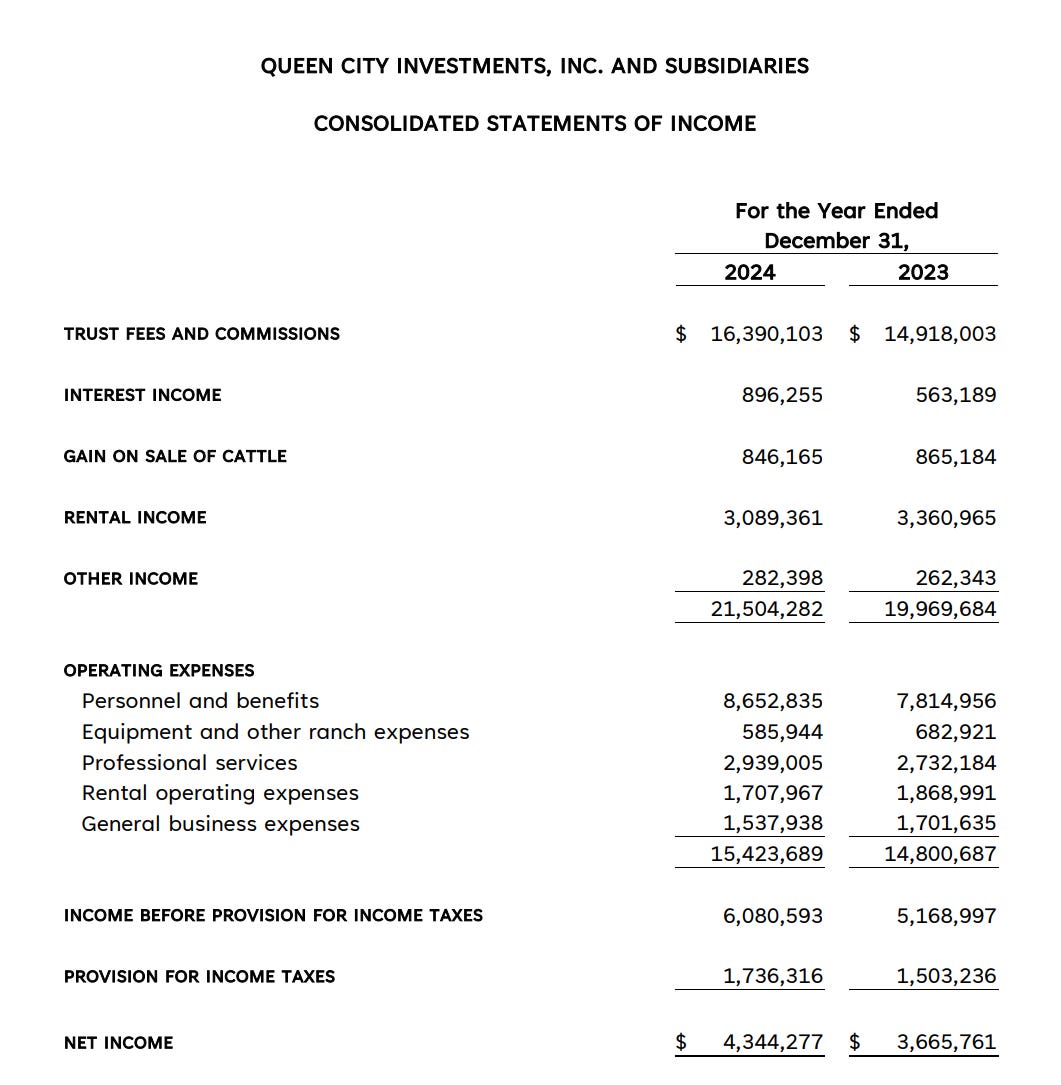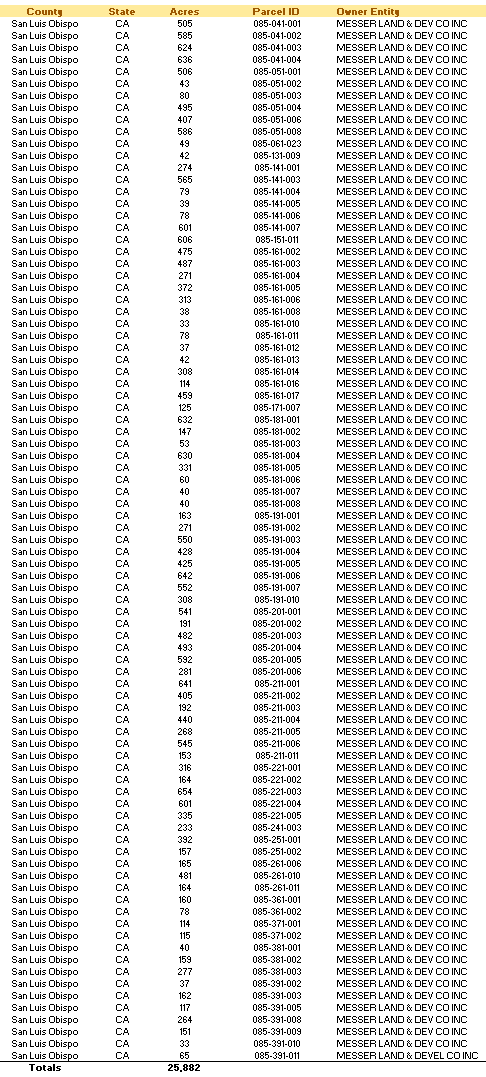Ranch-to-Market
Queen City Investments - OTC:QUCT
Overview
Queen City Investments, Inc. (“QUCT”) has been long considered a quasi-family office and value trap in microcap investing circles. The family-controlled business has historically traded at a significant discount to its breakup value because of its track record of poor capital allocation under the guise of conservatism. However, the Walker family (>50% shareholder) may be changing its tune.
Excess capital is being returned to shareholders in dribs and drabs via share repurchases, and a significant asset sale is being considered. Past frustrations with limited disclosures, an idle stock price, and cagey management have caused many investors to overlook this situation.
I believe QUCT shares are worth in excess of $3,000 on current earnings power and latent asset value, with a well-protected downside at the current price of $1,800/share.
The Walkers
In October 1907, amid a run on the bank, C.J. Walker took control of Farmers and Merchants Bank of Long Beach (FMBL). C.J. supposedly arrived by horse-drawn carriage with $500,000 in gold bars, calming anxious depositors and restoring the community’s confidence in the bank.
Today, the fourth and fifth generations of the Walker family continue to lead FMBL1. C.J.’s grandson, Ken Walker, formed Queen City as an investment holding company within FMBL. Queen City was spun out of FMBL in the early-1970s, though the two businesses maintain a symbiotic relationship (QUCT banks with FMBL, FMBL shares its office space with QUCT, etc.)
For the financial history buffs, FMBL has a neat ~130 page e-book on its website covering the bank’s 100+ year history.
Main Thesis Points: Three Sources of Value
Trust Business
Real Estate
Cash and Investments
Farmers & Merchants Trust Company of Long Beach (F&M Trust)
F&M Trust provides professional trust and investment management services to high-net-worth individuals, families, non-profits, and businesses. F&M has been in business since 1920, making it the oldest state-chartered trust company in California.
California Trust companies are regulated under the Department of Financial Protection and Innovation, and F&M is one of only seven chartered trust companies in the state. Trust companies face lighter regulation than banks, but they still operate under complex, specialized rules in this niche of asset management.
It would be bloody difficult to obtain a trust company charter in California. Charter applications with the DFPI might take two or more years to process. There are significant capital requirements, trust officers must undergo background checks, strict AML/KYC compliance standards must be met, etc. And if that’s not enough to scare you away, the feds (FDIC, OCC, etc.) may decide to insert themselves into the vetting process.
F&M Trust has fiduciary assets of $6 billion, representing 1,508 accounts as of June 30, 2025. It has five office locations in wealthy southern California regions (i.e., Laguna Hills, Santa Barbara, Long Beach, Torrance, and Newport Beach.)
Assets under management have nearly tripled over the past decade, and trust fees and commissions have grown at a high-single-digit rate, reaching $16.4 million in 2024. The Trust requires very little capital to grow, and I suppose it could operate at 30-40% pre-tax margins as a standalone business.
Queen City does not disclose quarterly results, only an annual report. Unsurprisingly, the annual report does not disaggregate operating income by business segment. So, if we take all parent company operating expenses for personnel and benefits ($8.6 million), professional services ($2.9 million), and general business expenses ($1.5 million) we get to a conservative estimate of approximately $3.3 million pre-tax earnings for the Trust segment.
Comparable trust businesses like Northern Trust and Bank of New York Mellon tend to trade around 14-15x NTM earnings. Applying a 10-15x range to F&M Trust’s estimated segment earnings of $3 million to $4 million suggests a potential valuation range in the $30 million to $60 million ballpark.
While I’m not expecting F&M Trust to be sold, an acquisition could fetch more than $60 million. A strategic buyer with the benefits of scale might be able to expand margins by plugging F&M into a national/global wealth management platform and trimming down administrative and back-office expenses. An acquirer paying a 15x multiple on $5 million in pro forma operating income gets us to $75 million.
Rental Properties and Ranch Land
In addition to the Trust business, Queen City owns a portfolio of free-and-clear real estate positions through its subsidiaries: QCI Real Estate Holdings and Messer Land & Development.
QCI owns four southern-California commercial properties, including an office building in Torrance, a net-leased Burger King in Long Beach, a mixed-use building in Santa Barbara, and a vacant industrial property in Goleta. Applying a 6% to 7% cap rate range to the commercial properties' estimated NOI of $1.4 million (ascribing zero value to the vacant industrial property) we get to a value range of $20 million to $23 million for the commercial properties.
Messer Land & Development owns a massive, 26,000-acre contiguous cattle ranch in the Huasna Valley in San Luis Obispo County. Supposedly FMBL foreclosed on the ranch in the early-1970s, and the property was sold to Queen City right around the time of the spinoff. The ranch more or less breaks even and manages a herd of approximately 1,000 cattle. According to a shareholder who attended the Queen City annual meeting, the Walker family is committed to selling the ranch. Interesting!
Recent farm and ranch sales in the San Luis Obispo County have traded between $1,400 and $7,500/acre. For instance, Estrella Ranch in Paso Robles reportedly sold for $35 million, or $1,666/acre. Ted Cooper Ranch is listed for $4,411/acre. Indian Knob Ranch in San Luis Obispo is supposedly under contract for around $7,450/acre.
These transactions aren’t perfectly comparable. Some of these properties have large, luxurious ranch homes without livestock or vice versa, and I’m not exactly sure what improvements lie on the Huasna ranch.
So, if we use the lower end of the range of $1,500 to $3,500/acre for the ranch we get to an approximate value of $39 million to $91 million for the Huasna ranch.
For anyone looking to dig a bit deeper on the ranch land, I recommend querying the San Luis Obispo County ArcGIS Open Data portal and Tax Collector websites and here and here.
Cash and Investments
QUCT holds $13.5 million of cash and approximately $20.7 million of US Treasury bills on its balance sheet, representing ~$700/share of value.I believe most cash and short-term investments on the balance sheet represents excess capital. QUCT could easily sell its T-Bill portfolio tomorrow and use the proceeds to either repurchase a big chunk of the company or issue a >$600/share dividend.
Summing it up
Sum of the parts analyses can be dangerous, unless you think you can get the parts. Over a long enough time horizon, I think QUCT shareholders will get the parts and the discount to intrinsic value will narrow.
The way I look at it, I am paying a reasonable price for the real estate (i.e., the ranch and rental properties) and I’m getting the high-quality Trust business for “free”. In the meantime, who knows? Maybe we wake up one day and Huasna ranch sells for a fancy price.
Disclosure: I own shares of Queen City Investments, Inc.
References
https://www.latimes.com/business/la-xpm-2011-nov-29-la-fi-farmers-merchants-20111129-story.html
https://www.fmb.com/-/media/brochures/fmb_110_yearbook.pdf?rev=aaa2608b643d4a77bd344bd766bf24ef
http://www.oddballstocks.com/2011/12/investigating-unlisted-stock.html?m=1
https://www.valueinvestorsclub.com/idea/QUEEN_CITY_INVESTMENTS_INC/1853363830#messages
As pointed out by Margin of Danger on Twitter, FMBL’s proxy statement lowered the shareholder approval threshold for a sale from 80% to 65%. This leads me to believe that the Walker family may be positioning FMBL for a sale.









Out of interest I looked up how much $500,000 worth of gold in 1907 would be worth today. $87 million, apparently. QUCT's market cap? $84 million.
Nothing to do with the post. Just thought that was funny. Probably not apples to apples.
Great find!